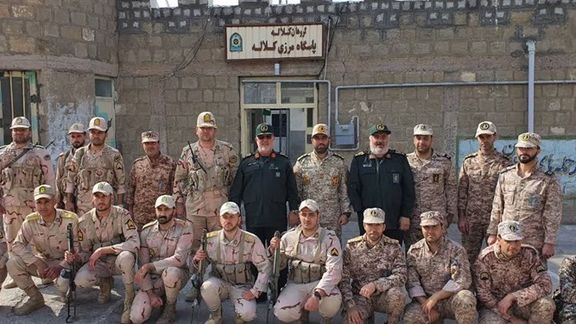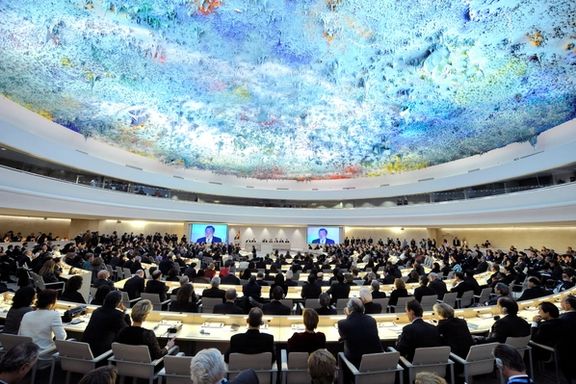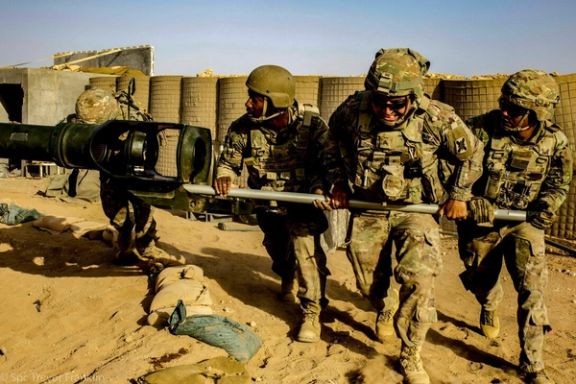Pro-Iran Forces Launch Second Attack On US Forces In Syria

Tehran-linked groups targeted US forces in Syria for a second day in a row Friday, after the United States conducted an air strike against their bases following a drone strike Thursday.

Tehran-linked groups targeted US forces in Syria for a second day in a row Friday, after the United States conducted an air strike against their bases following a drone strike Thursday.
White House National Security Council spokesman John Kirby said no American personnel were hurt in the new attack in northeast Syria, calling the incident an initial reaction to US retaliatory strikes on Iran-aligned groups in the area.
"It is not uncommon, when we take a retaliatory strike like this, for them to answer right back with some ineffective rocket fire. And these were largely, completely ineffective," Kirby told MSNBC. "Nobody was hurt, no US casualties at all."
The attack on Thursday with a suicide drone killed a US contractor and injured several servicemen. The US immediately retaliated with air strikes.
The US intelligence community assessed that the one-way attack drone was Iranian in origin, the Pentagon said, a conclusion that could further aggravate already strained relations between Washington and Tehran.
The new rocket attack by Iran-linked forces targeted a US base near the Al-Omar oil field. Lebanese pro-Iranian TV channel Al Mayadeen was first to report the attack.
The attacks by Iranian-led groups come just two weeks after Tehran signed a deal with Saudi Arabia to restore relations, a move seen by analysts as potentially beneficial for stability in the region.

A war monitor says the US airstrikes on positions of Iran-backed militias in eastern Syrian city of Deir ez-Zur (Deyrizor) have killed eights militiamen, after a deadly drone strike targeted American forces in the area.
The Britain-based Syrian Observatory for Human Rights said the attacks were carried out in the early hours of Friday local time by US fighter jets and drones, targeting positions of the Iranian Revolutionary Guards (IRGC) in Al-Bokamal desert, as well as other positions on the southern outskirts of Al-Mayadeen city and an ammunition warehouse opposite the “Officers Residences” in Harabesh neighborhood in Deir ez-Zur city.
The airstrikes left at least eight Iranian-backed militiamen dead: six in the warehouse in Harabesh and two in the position on the outskirts of Al-Mayadeen. According to the observatory, the number of fatalities is expected to rise as the strikes left several other militiamen injured, some seriously. The strikes also caused heavy material damage.
Also Friday morning -- at around 11 a.m. local time (0800 GMT) -- Iran-backed forces stationed in a base near Ain Ali shrine in Al-Mayadeen countryside fired several missiles towards Al-Omar oilfield which hosts the US-led International Coalition’s largest base in Syria.
The Pentagon said earlier in the day that the US military carried out the attack against militia groups who it blamed for a drone attack on Thursday that killed an American contractor, injured another, and wounded five US troops.
The US intelligence community assessed that the one-way attack drone was Iranian in origin, the military said, a conclusion that could further aggravate already strained tensions between Washington and Tehran.

Iran’s Revolutionary Guard Ground Force commander visited border regions in the northwest near Armenia and Azerbaijan where tensions between the two Transcaucasian countries have spiked.
Brigadier-General Mohammad Pakpour visited an area under control of IRGC’s Ashura camp located around the common borders of Armenia and Azerbaijan, where a resumption of military conflict is feared. The two countries fought a war in 2020 over disputed territories and Yerevan has accused Baku of recent border incursions.
Although the Islamic Republic says it is neutral in the conflict but it has warned it would not tolerate changes to international borders.
Iranian media have reported in recent weeks that Azerbaijan is preparing for a potential attack on Armenia, without elaborating on the details. Earlier in the week, Aftab News, a website believed to be close to former President Hassan Rouhani and the Moderation and Development Party, quoted Baku’s Ambassador to Iran Ali Alizada as criticizing “smuggling of military supplies into Khankendi by Armenian separatists.” The area is called Stepanakert in Armenia. “Time to act,” he urged.
Earlier in the month, Foreign Ministry of Azerbaijan summoned the Iranian ambassador in Baku to protest the flight of an Iranian warplane on the border of the two countries. Ambassador Abbas Mousavi was told that the warplane continuously flew near the Azerbaijani border for more than 40 minutes at a distance of 3-5 kilometers on March 11.
After a gunman assaulted Azerbaijan’s embassy in capital Tehran, Baku says it is evacuating staff and family members from the country. The incident came amid increased tensions between the neighboring countries triggered by territorial conflict between Azerbaijan and Armenia and Yerevan as well as over Baku's decision this month to appoint its first ever ambassador to Israel.
Iran is dangerously implicated in regional tensions centered on Azerbaijan-Armenia that are exacerbated by fall-out from Russia’s war in Ukraine.

The Nowruz holidays weren’t the happiest of days for Iran’s diplomats at the UN in Geneva, coinciding as it did with a highly critical report by the UN’s Special Rapporteur Javaid Rehman.
Almost six months to the day since the death of Gina Mahsa Amini, the 47-member states of the Human Right Council delivered their opinions on the Report in two meetings of the so-called Interactive Dialogue with the Special Rapporteur on the situation of human rights in Iran. The Council will vote on the report on either the 3rd or 4th April, at the close of its 52nd Session, which began on 27 February.
The 20-page Report, published in February, details the evidence of serious violations of human rights, including murder, imprisonment and forced disappearances, torture, rape and sexual violence and persecution in the context of protests that began last September. Professor Rehman says, “these were part of a systematic, widespread and state instigated policy…the scale of gravity of these crimes points to the possible commission of crimes against humanity.”
This was the Report’s first council outing for comment from member States. The majority of the Council members, some thirty countries, voiced overwhelming support for Rehman’s Report and its conclusions. Iran’s isolation on the world stage was on physical display in the huge, white, brightly lit circular Council chamber as ambassadors from country after country spoke in favor of Prof. Rehman’s findings and conclusions.
The sheer size of the Council chamber concentrates attention on what is being said: despite its size, it is a quiet space as all communication is through microphone and interpreter. Diplomats, press, delegates from dozens of NGOs and other organizations all listen with an earpiece.

There was a tension waiting to see how Iran, as ‘country of concern’ in UN language with right of first reply, would respond to Rehman’s summary.
Iran’s response in the Council was to go on the attack. Ambassador Ali Bahreini, head of the Iranian delegation at the UN in Geneva, sat stony-faced through Rehman’s summary of his Report at the beginning of the first session. Speaking in English, Bahreini called on “the spirit of spring and Nowruz (to) bring dignity, honesty and justice to our world” before moving on to say that Rahman was “in total disregard of his duties under Resolution 5/2, which emphasizes the impartiality of the special rapporteurs”. Bahreini said that Rehman “plays the role of the opposition. In all his writings and statements, he uses biased languages and violates the code of conduct of the special mandate holders.”
The Special Rapporteur maintained his characteristic imperturbability while the Ambassador described the Report as reading like a “tragic novel…allegations made by Mr. Javaid Rehman…have been repeated by a number of Western governments and their media outlets and terrorist groups stationed in their countries in the past months. They tried to portray their imagination as the reality of human rights situation in Iran.”
But beyond this, Mr Bahreini did not expand on what he understood to be the reality of the human rights situation in Iran. And the Ambassador left: no further appearance, no press conference.
While most of the Council members backed Rehman’s Report, there were dissenters: Russia, Syria, China, and Belarus were among the seven states who gave a negative response to the report (joined by Zimbabwe, Cuba and Laos).
Their statements did not dispute the facts in the Report but were a more general complaint about the “politicization” of human rights issues by Western countries and a resistance to the idea of scrutiny outside state control.
Professor Rehman’s very lawyer-like insistence on accountability might also have played a part, carrying the possibility of international arrest warrants being issued against state actors incriminated in human rights violations - Rehman gave the example of Hamid Nouri’s arrest and trial and the ongoing case of Flight PS752 in the International Criminal Court. News of the international arrest warrant issued against President Vladimir Putin was fresh in everyone’s mind.
We didn’t hear from Ambassador Bahraini again, but Professor Rehman seemed to be everywhere. As well as the two sessions in the Council itself, Javaid Rehman gave a press conference and spoke at several side events organized by bodies such as Article 19, Iran Human Rights, the Ensemble center la Seine de mort, International Federation of Journalists and others.
The mild-mannered, softly spoken Special Rapporteur has over the past few months been increasingly outspoken about human rights in Iran. Prof. Rehman has had the mandate since 2018 and has consistently called upon Iran to allow him into the country and to engage with his mandate, which Iran does not recognize. As for Iran’s criticism of his findings, Rehman says his report is based on fact and is not subjective and calls for Iran to give him substantive replies - and to let him in and engage with him.
“I should be reporting to you from Tehran,” he says.

The US military carried out air strikes in Syria Thursday night against Iran-backed militia groups who it blamed for a deadly drone attack on its forces.
The attack killed an American contractor, injured another, and wounded five US troops earlier in the day, the Pentagon said.
Both the attack on US personnel and the retaliation were disclosed by the Pentagon at the same time late on Thursday.
The attack against took place at a coalition base near Hasakah in northeast Syria at approximately 1:38 p.m. (1038 GMT) on Thursday, it said.
The US intelligence community assessed that the one-way attack drone was Iranian in origin, the military said, a conclusion that could further aggravate already strained tensions between Washington and Tehran.
The decision to launch the drone attack against US forces came two weeks after Iran and Saudi Arabia agreed to re-establish relations with Chinese mediation, a development that many analysts saw as a sign of tension-reduction in the region.
US Defense Secretary Lloyd Austin said the retaliatory strikes were carried out at the direction of President Joe Biden and targeted facilities used by groups affiliated with Iran's Islamic Revolutionary Guard Corps (IRGC).

"The air strikes were conducted in response to today’s attack as well as a series of recent attacks against Coalition forces in Syria by groups affiliated with the IRGC," Austin said in a statement.
"No group will strike our troops with impunity."
Three service members and a contractor required medical evacuation to Iraq, where the US-led coalition battling the remnants of Islamic State has medical facilities, the military said.
The other two wounded American troops were treated at the base in northeast Syria, the Pentagon said.
The number of casualties - one killed and six wounded - is highly unusual, even though attempted drone attacks against US personnel in Syria are somewhat common.

US troops have come under attack by Iranian-backed groups about 78 times since the beginning of 2021, according to Army General Erik Kurilla, who oversees US troops in the Middle East as the head of Central Command.
Kurilla, testifying to the House Armed Services Committee earlier on Thursday, cautioned about Iran's fleet of drones.
"The Iranian regime now holds the largest and most capable unmanned aerial vehicle force in the region," he said.
Three drones targeted a US base in January in Syria's Al-Tanf region. The US military said two of the drones were shot down while the remaining drone hit the compound, injuring two members of the Syrian Free Army forces.
U.S. officials believe drone and rocket attacks are being directed by Iran-backed militia, deployed in Syria for more than decade to support the country’s controversial president Bashar al-Assad and expand Tehran’s influence in the region.
The attack came just weeks after the top US general, Mark Milley, visited northeast Syria to assess the mission against Islamic State and the risk to U.S. personnel.
Asked by reporters traveling with him at the time if he believed the deployment of roughly 900 US troops to Syria was worth the risk, Milley tied the mission to the security of the United States and its allies, saying: "If you think that that's important, then the answer is 'Yes.'"
"I happen to think that's important," Milley said.
Thousands of Islamic State fighters are in detention facilities guarded by Kurdish-led Syrian Democratic Forces, America's key ally in the country.
American officials say that Islamic State could still regenerate into a major threat.
The mission, which former President Donald Trump nearly ended in 2018 before softening his withdrawal plans, is a remnant of the larger global war against terrorism that had included once the war in Afghanistan and a far larger U.S. military deployment to Iraq.
Reporting by Reuters

The ultraconservative Paydari [Steadfastness] party is often blamed in Iran for most of the country's political, economic and social-cultural problems.
The party emerged in Iran under populist President Mahmoud Ahmadinejad (2005-2013) but it also left its impact on political life under presidents Hassan Rouhani (2013-2021) and Ebrahim Raisi (2021 onward).
A report in the moderate conservative Khabar Online website on March 22 characterized Paydari as a party that has adversely affected "Iran's progress" by standing against the people's wishes. The party has an opaque leadership, but its fingers can be seen pulling the strings everywhere.

According to Khabar Online, during the past year, Paydari prioritized its own factional interests over the country's national interests and as a result, Iran lagged other countries on the route to development. Most of what the party has been doing at the parliament were about restricting people's access to the Internet, promoting the idea of use of force against dissidents and invading Iranians' private lives by backing forced hijab and other religious rules.
Some of these fundamentalist approaches led to recent nationwide protests. The party's intervention in every aspect of life has often annoyed the populace. Many reacted with frustration and anger when the party's mouthpiece Raja News website demanded persecution and harsh punishment for a female stand-up comedian who makes fun of regime politicians.

Khabar Online charged that while the people's welfare and livelihood is the country's most important problem, Paydari members, who constitute the majority in the Iranian parliament are concerned about Iranian women's defiance to compulsory hijab.
Although not all the party's members are known to the public, views expressed by politicians in the past two decades have revealed to keen Iran watchers that even some high-ranking IRGC generals also subscribe to Paydari's fundamentalist ideology. Some of these generals are now members of the parliament with or without their uniforms.
On the other hand, many Raisi's cabinet members, including most of those on his economic team are said to be the leading members of Paydari. The party's link to Raisi became evident during his Presidential election campaign when its leading members such as former nuclear negotiator Saeed Jalili were active. However, like many other areas in Iranian politics, it is never clear who is the cart and who is the horse. Is Raisi using Paydari or is the party using the president?
Paydari is also known for its ruthless opposition to the revival of nuclear deal (JCPOA) with world powers, which some argue aligns with the murky role Russia has been playing in the nuclear issue.
During 2014 and 2015 when the agreement was being negotiated, opposition to the deal at the parliament came mainly from Paydari lawmakers or those who were close to the party.
On the economic front, although a minority at the Majles worked hard to impeach Raisi's economic ministers, Paydari members obstructed all the motions in collaboration with their allies at the presidium, Khabar Online wrote, echoing other media in Iran.
In the cultural sphere, Paydari has always defended the most hard-line policies over hijab and restricting civil liberties, while virtually doing nothing to help revive the economy.
The most damaging policies followed by Paydari have been the attack on the Saudi Embassy in Tehran in 2016 by "rouge elements" and the party's explicit opposition to a nuclear deal that could have saved the nation from economic misery, the moderate-conservative website said.